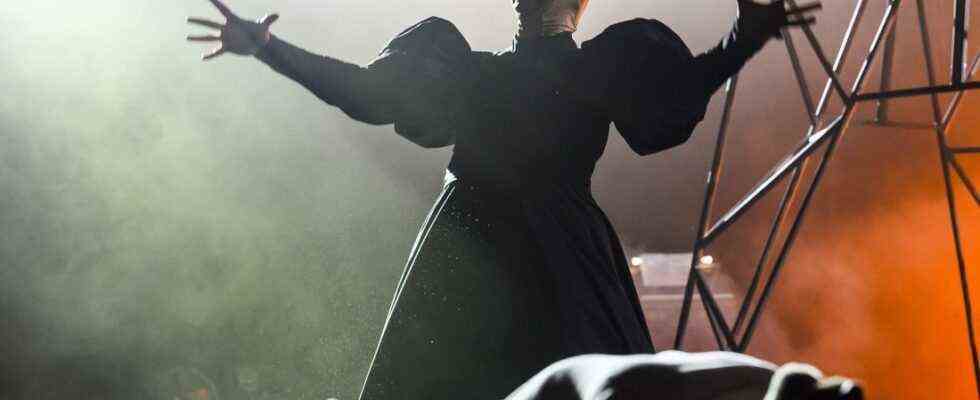It is very fair that the Schauspiel Leipzig does not suppress the reaction that Günter Grass’ book triggered after its publication in 1986 in its program booklet on “Rättin”. Before it was published, a caustic parody entitled “The Grass” appeared in book form, the author of which has remained undiscovered to this day. The German feature section crushed the intention, form and content of the 500-page long dystopia about the self-destruction of mankind and its successor as the crown of creation, Rattus norvegicus. Marcel Reich-Ranicki’s famous total dismantling, entitled “A catastrophic book”, in which he found the novel “inedible”, is even printed in the booklet accompanying Claudia Bauer’s production.
The author finally fled from these damning judgments to Calcutta, where the two peoples of his novel still live together. But looking back, this crude fable contains a lot of formulations, scenic ideas and structural considerations that read as if they were in blogs by Extinction Rebellion or Fridays for Future activists. Because in Grass’ satire on the last man in a space capsule it was already in the eighties about the inability of the “human race” to recognize the consequences of the unrestrained consumption of the world and to initiate the necessary changes. And that reads more like an outlook on the immediate future than a completely failed novel from the time of extreme consumerism during the Cold War.
All of Grass’ self-quotes are described without malice – and thus received completely differently than by the critics
Grass’ defeatist prospect of a suicidal human world order therefore offers astonishingly colorful material for a stage grotesque about the uncertain present, in which the two-legged still want to eat, buy, live, travel and hate, as if there were no scientific counter-arguments to this lifestyle. And in later recognition of Grass’ foresight, Claudia Bauer and her dramaturge Matthias Döpke developed a theatrical version of the “Rättin”, which apart from a few updated vocabulary and references to the objections of the 21st century (“How dare you?”) Is a pretty good one provides a faithful summary of the original.
The long conversation between the last person and a she-rat, the revolt of Grimm’s fairy-tale characters against the German government because of the dying forest, the search for the saving legendary city of Vineta in a jellyfish-infested Baltic Sea, the crossing of the new hybrid future race of rats and punks, but also the appearance the adult brass drummer Oskar Matzerath or the Butt as self-quotations are portrayed without malice in the production – and thus received completely differently than after the publication of the novel by the German critics.
Bauer stages the many narrative strands as musical group choreographies with isolated solo numbers.
(Photo: Rolf Arnold)
An astonishingly fit leading actor, who can even speak his texts on the treadmill without losing breath, shows the stubborn last person as unteachable. “We still decide when the shop closes”, shouts Tilo Krügel, the “man” in the space capsule. Believing that there is still a “we” of humanity, he talks about radio news and film projects. “Humans do not want to change even in times of need”, recognize the resilience world champions with the bare tails, who have long since taken control of the contaminated globe after the final nuclear war, with head-shaking resignation.
Bauer stages the many narrative strands as musical group choreographies with isolated solo numbers. Everything on an empty stage with a space capsule, which is reminiscent of the first lunar module of the Apollo mission – albeit made cozy with potted plants. The set designer Andreas Auerbach lets 20 tree trunks dance up and down, while Vanessa Rust brings up a colorful potpourri of children’s book and festival ball costumes, which, however, at least for the fairy tale characters, are clearly based on Grass’ descriptions – up to exaggeratedly large breasts.
What seems so silly or pretentious when reading the novel becomes highly compatible here
There are also many camera actions on stage, because the last person is shooting the revolution of fairy tale characters against environmental destruction as a silent film for the successful porn producer Oskar Matzerath. For the very impressive music, Hubert Wild quotes the motif from Spielberg’s “Close Encounters of the Third Kind”, the hit “Road to Nowhere” Talking heads or cutting opera arias. So the “Rättin” becomes a doomsday revue with high entertainment value. Taken lightly and served with humor, what seems so silly or pretentious when reading the novel turns out to be highly compatible with current cross-culture. Trash and drama get along particularly well when it comes to human disposal.
Claudia Bauer’s brisk show of thoughtfulness, however, does not fail to emphasize the decisive sentences of social criticism in such a way that they help the hubris of going on with a threatening sound. And she ridicules those forms of masculinity that actually don’t really control anything except to spread the belief that she has everything under control. The last man in his space capsule in this parody is the classic type of today’s politician and consumer who has all relevant information available only to ignore it. While he shouts in space: “I’m crazy about life”, Rattus norvegicus dances a new world order in solidarity towards the end of the Anthropocene. Wasn’t Grass a prophet?

